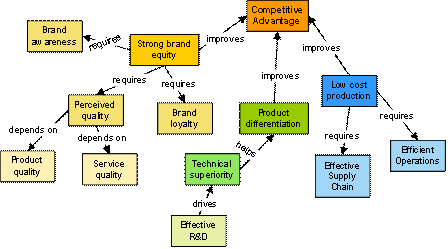Development of a Next-Generation Intervention Process with Modeling and Visualization Support
Strategy Modelling and Visualization
Strategic problem solving is a complicated task that requires processing of large amount of information using theoretical knowledge and practical experience.
Verbal or textual descriptions are inadequate for dealing with this complexity. Issues of causality, importance, priority relationships, the relationship between variables, and so on are very difficult to engage with when expressed in words .
There are various visualization and visual modelling tools (Figure 1) (e.g. Concept Maps, Figure 2) that support strategic analysis and decision-making, but they are not easily accessible.

Figure 1 Modelling and Visualization Framework

Figure 2 Concept Map Representation of Competitive Advantage
The aim of this research project is to underpin an industrial support activity that provides companies with help in strategic problem solving using modelling and visualization tools.
Next Generation Diagnostic Intervention
Managers of manufacturing companies need to be able to target effort and attention to those parts of the business where they are most needed. Processes are needed to take a holistic look at the business, diagnose the major problems and provide an action plan to correct any major weaknesses. Although many such processes are available, there is an opportunity to better encompass strategic analysis and decision-making within them. The aim of this research project is to develop a comprehensive diagnostic process to address this issue.

Strategy Modelling & Visualization in Diagnostic Intervention
The Strategy Modelling & Visualization and the Next Generation Diagnostic Intervention projects work collaboratively. The objective of this collaboration is to derive benefits from the synergies between the two strands. It is intended that the Next Generation process will benefit from incorporating appropriate modelling and visualization techniques where suitable, and that it will also act as a vehicle for researching the techniques in practical applications.
The Institute's own diagnostic process, In-site , has been used to initiate many performance improvement projects in local SMEs in the last year. Over the next 12 months we will be asking companies to join us in a programme to design a 'next generation' tool - incorporating strategy formulation, and using modelling and visualization techniques. This will be an exciting opportunity to get involved with the Institute, and to benefit from the improved tool early!









